Related Research Articles
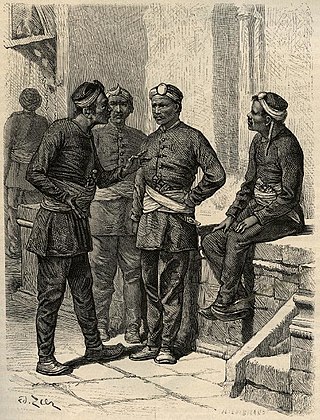
The Gurkhas or Gorkhas, with the endonym Gorkhali, are soldiers native to the Indian subcontinent, chiefly residing within Nepal and some parts of North India.
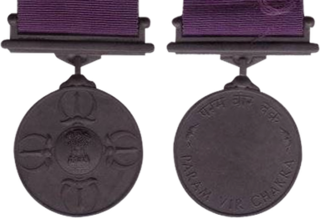
The Param Vir Chakra (PVC) is India's highest military decoration, awarded for displaying distinguished acts of valour during wartime. Param Vir Chakra translates as the "Supreme Wheel of Bravery", and the award is granted for "most conspicuous bravery in the presence of the enemy". As of January 2018, the medal has been awarded 21 times, of which 14 were posthumous and 16 arose from actions in Indo-Pakistani conflicts. Of the 21 awardees, 20 have been from the Indian Army and one has been from the Indian Air Force. Major Somnath Sharma was the first recipient. A number of state governments of India as well as ministries of the central government provide allowances and rewards to recipients of the PVC.

Subedar Major Gyamtso Shangdarpa, better known as Ganju Lama was born in the Kingdom of Sikkim on 22 July 1924 to Shangdarpa parents of the Bhutia Community. The etymology of the name "Ganju Lama" tells us that during the Chogyal period, sons of the Shangdarpa clan were expected to serve as monks. He enlisted in the British Indian Army in 1942 at the age of seventeen, as a rifleman in the 1st battalion, 7th Gurkha rifles. The Gurkha regiments were in dire need of manpower and would accept anyone who closely resembled a Gurkha. He is the only Bhutia recipient of the Victoria Cross, the highest and most prestigious award for gallantry in the face of the enemy that can be awarded to British and Commonwealth forces.

Mir Dast, was a British Indian soldier and a recipient of the Victoria Cross for action during the First World War, the highest award for gallantry in the face of the enemy that can be awarded to British and Commonwealth forces.

Lalbahadur Thapa Magar VC was a Nepali Gorkha recipient of the Victoria Cross, the highest and most prestigious award for gallantry in the face of the enemy that can be awarded to British and Commonwealth forces.
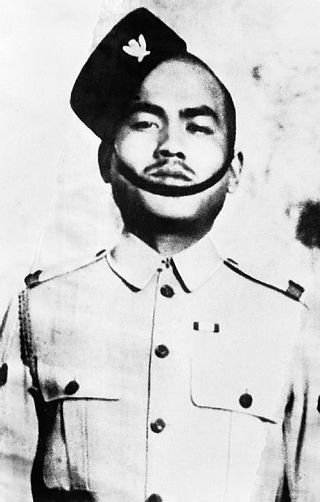
Netrabahadur Thapa Magar VC was a Nepalese Gurkha recipient of the Victoria Cross, the highest and most prestigious award for gallantry in the face of the enemy that can be awarded to British and Commonwealth forces.
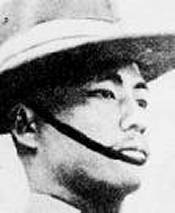
Gaje Ghale VC was a Nepalese Gurkha recipient of the Victoria Cross, the highest and most prestigious award for gallantry in the face of the enemy that can be awarded to British and Commonwealth forces.
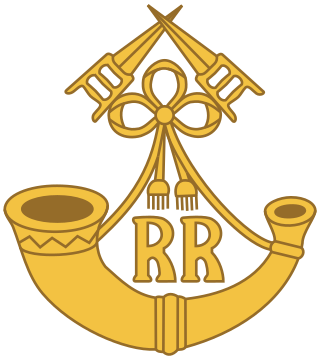
The Rajputana Rifles is the oldest rifle regiment of the Indian Army. It was originally a part of the British Indian Army, when six previously existing regiments were amalgamated to form six battalions of the 6th Rajputana Rifles. In 1945, the numeral designation was dropped from the title and in 1947 the regiment was transferred to the newly independent Indian Army. Since independence, the regiment has been involved in a number of conflicts against Pakistan, as well as contributing to the Custodian Force (India) in Korea under the aegis of the United Nations in 1953–54 and to the UN Mission to the Congo in 1962. As a rifle regiment, it uses a bugle horn as its insignia, the same as the British Light Division, but unlike its British counterparts, the Rajputana Rifles march at the same march pace used in the Indian Army as a whole.
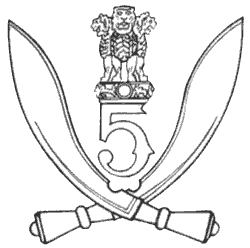
5th Gorkha Rifles, also abbreviated as 5 GR(FF) is an infantry regiment of the Indian Army comprising Gurkha soldiers of Nepalese origin. It was formed in 1858 as part of the British Indian Army. The regiment's battalions served in the First World War (Mesopotamia) and Second World War.
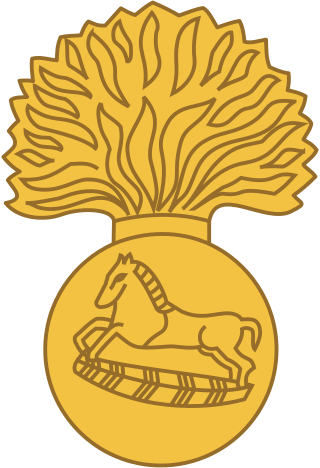
The Grenadiers is an infantry regiment of the Indian Army, formerly part of the Bombay Army and later the pre-independence British Indian Army, when the regiment was known as the 4th Bombay Grenadiers. It has distinguished itself during the two world wars and also since the Independence of India. The regiment has won many battle honours and gallantry awards, and is considered to be one of India's most decorated regiments with three Param Vir Chakra awardees in three different conflicts.
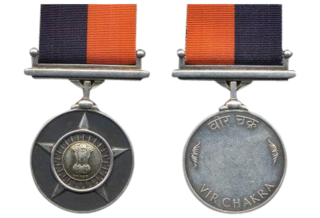
The Vir Chakra is an Indian wartime military bravery award presented for acts of gallantry on the battlefield, on land or in the air or at sea.
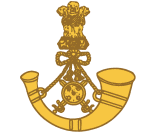
The Maratha Light Infantry is a light infantry regiment of the Indian Army. It traces its lineage to the Bombay Sepoys, raised in 1768, making it the most senior light infantry regiment in the Indian Army.

The Indian Order of Merit (IOM) was a military and civilian decoration of British India. It was established in 1837, although following the Partition of India in 1947 it was decided to discontinue the award and in 1954 a separate Indian honours system was developed, to act retrospectively to 1947. For a long period of time the IOM was the highest decoration that a native member of the British Indian Army could receive and initially it had three divisions. This was changed in 1911 when Indian servicemen became eligible for the Victoria Cross. A civilian division of the IOM also existed between 1902 and 1939, however, it was only conferred very rarely.

The Order of British India was an order of merit established in 1837 by the East India Company for "long, faithful and honourable service". The company's powers were removed after the Indian Mutiny, and the Order was incorporated into the British Honours System in 1859. The order became obsolete in 1947, after the partition of British India into the Dominion of India and the Dominion of Pakistan.

The Garhwal Rifles, formerly known as the Royal Garhwal Rifles, are an infantry regiment of the Indian Army. It was originally raised in 1887 as the 39th (Garhwal) Regiment of the Bengal Army. It then became part of the British Indian Army, and after the Independence of India, it was incorporated into the Indian Army.

The 8th Gorkha Rifles is a Gorkha regiment of the Indian Army. It was raised in 1824 as part of the British East India Company and later transferred to the British Indian Army after the Indian Rebellion of 1857. The regiment served in World War I and World War II, before being one of the six Gurkha regiments transferred to the Indian Army after independence in 1947. Since then it has served in a number of conflicts including the Sino-Indian War of 1962 and the Indo-Pakistan wars of 1965 and 1971. Today the 8th Gorkha Rifles is one of the most celebrated regiments of the Indian Army, having received numerous citations for bravery in the field of battle, and even producing one of the two field marshals of India, Field Marshal Sam Manekshaw, of the Indian Army.

The siege of the Sherpur Cantonment was a battle fought in December 1879, during the Second Anglo-Afghan War.
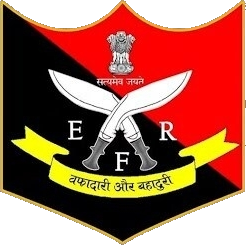
The Eastern Frontier Rifles (EFR) are a State Armed Police Force for the Indian state of West Bengal. They are a part of the West Bengal Police, as opposed to the Kolkata jurisdiction. The Border Guards Bangladesh are descended from the portion of the Eastern Frontier Rifles given to Pakistan during the partitioning of 1947.

The Hazara Expedition of 1888, also known as the Black Mountain Expedition or the First Hazara Expedition, was a military campaign by the British against Swati and Yousafzai tribes of Kala Dhaka and Battagram District in the Hazara region of what is now Pakistan.
Havildar Kabir Pun, IOM, was a Nepalese soldier in the British Indian Army who received the Indian Order of Merit for his gallantry at Gyantse, during the Younghusband Expedition to Tibet (1903-4). Until 1911, the 1st class of the Indian Order of Merit (IOM), which had three classes, was the highest award available to native members of the British Indian Army. Pun was thus awarded the IOM since he could not be awarded the Victoria Cross (VC), being a native personnel.
References
- ↑ "Index to the Journal of Orders and Medals Research Society, Vol 12 (1973) to Vol 45 (2006)".
- 1 2 Haynes, Edward (2020). "The Evolution of Indian Orders, Decorations and Medals during the Era of the USI: 1870-2020". Journal of the United Service Institution of India. CL (622).
- 1 2 "The Indian Order of Merit 1837-1947 - DCM Medals". 2017-06-12. Retrieved 2024-05-13.
- 1 2 3 4 Weekes, H. E. (2011). History of the 5th Royal Gurkha Rifles : 1858 to 1928. Luton : Andrews UK. ISBN 978-1-78149-333-5.
- ↑ Tarin, Omar; Najmuddin, Sarkees (2010). "FIVE EARLY MILITARY GRAVES (c.1853-1888) AT THE OLD CHRISTIAN (ANGLICAN) CEMETERY, ABBOTTABAD, PAKISTAN" (PDF). Kipling Journal: 44.
- ↑ "History Of Gurkha – Gurkha Museum" . Retrieved 2024-05-13.
- 1 2 Cardozo, Maj Gen Ian (2016). The Bravest of the Brave: The Extraordinary Story of Indian VCs of World War I. Bloomsbury Publishing. ISBN 978-93-86141-76-7.